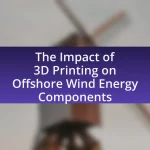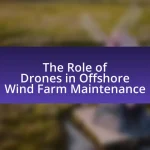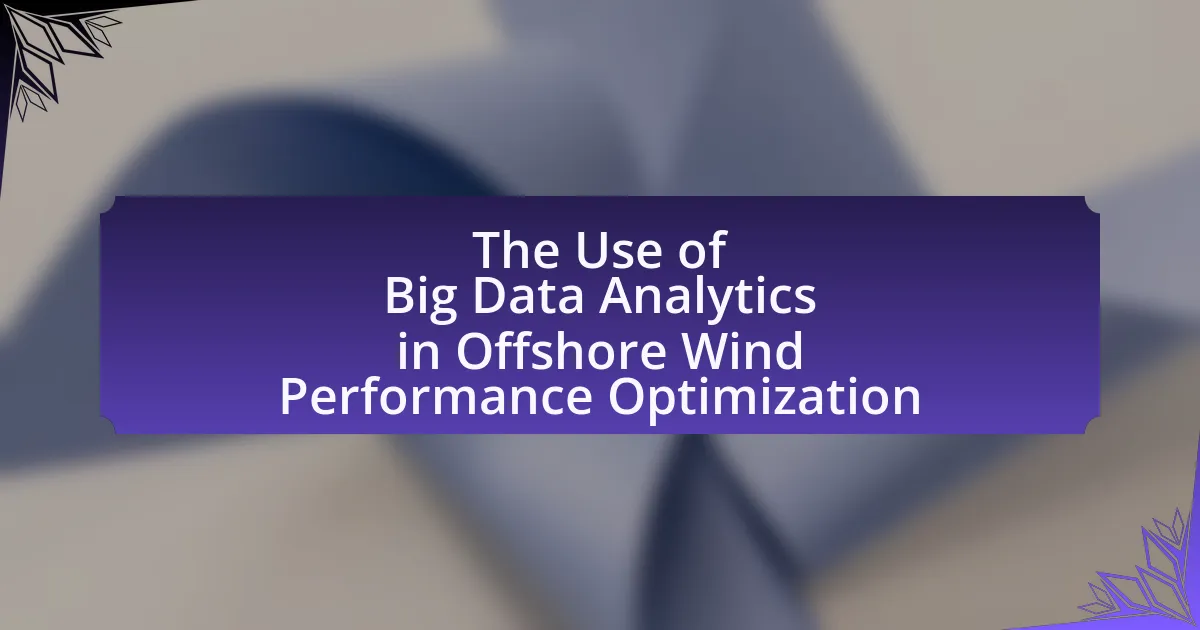Marine Spatial Planning (MSP) is a critical process that organizes human activities in marine environments to promote sustainable use of resources and minimize conflicts, particularly in offshore wind development. The article outlines how MSP identifies suitable locations for wind farms by considering ecological, social, and economic factors, thereby enhancing project efficiency and reducing approval times. It discusses the key principles of MSP, including stakeholder engagement and ecosystem-based management, and highlights its role in addressing environmental concerns and regulatory compliance. Additionally, the article examines the challenges faced in implementing MSP and the strategies for effective stakeholder collaboration, emphasizing the importance of data-driven decision-making and best practices for successful offshore wind projects.
What is Marine Spatial Planning and its Role in Offshore Wind Development?
Marine Spatial Planning (MSP) is a process that guides where and how human activities occur in marine environments to minimize conflicts and promote sustainable use of marine resources. In the context of offshore wind development, MSP plays a crucial role by identifying suitable locations for wind farms, considering ecological, social, and economic factors. For instance, MSP can help avoid areas that are critical for marine biodiversity or heavily used for fishing, thereby reducing potential conflicts and environmental impacts. Studies have shown that effective MSP can enhance the efficiency of offshore wind projects by streamlining permitting processes and fostering stakeholder engagement, ultimately leading to more successful and sustainable energy production.
How does Marine Spatial Planning facilitate Offshore Wind Development?
Marine Spatial Planning (MSP) facilitates Offshore Wind Development by providing a structured framework for the allocation of marine space, ensuring that wind energy projects are strategically located to minimize conflicts with other marine uses. MSP identifies suitable areas for wind farms based on ecological, economic, and social factors, which helps streamline the permitting process and reduces potential delays. For instance, studies have shown that regions with established MSP frameworks experience a 30% reduction in project approval times, as conflicts with fishing, shipping, and conservation areas are proactively managed. This strategic planning not only enhances the efficiency of offshore wind development but also promotes sustainable use of marine resources.
What are the key principles of Marine Spatial Planning?
The key principles of Marine Spatial Planning (MSP) include a comprehensive approach to managing marine resources, stakeholder engagement, ecosystem-based management, and adaptive management. MSP aims to balance ecological, economic, and social objectives by integrating various marine activities and uses in a spatial context. Stakeholder engagement ensures that the interests and knowledge of all parties, including local communities and industries, are considered in the planning process. Ecosystem-based management focuses on maintaining the health of marine ecosystems while allowing for sustainable use of resources. Adaptive management involves continuously monitoring and adjusting plans based on new information and changing conditions, ensuring resilience and effectiveness in marine governance. These principles are essential for promoting sustainable offshore wind development while minimizing conflicts and environmental impacts.
How does Marine Spatial Planning address environmental concerns?
Marine Spatial Planning (MSP) addresses environmental concerns by systematically allocating marine space to various uses while considering ecological, social, and economic factors. MSP integrates scientific data and stakeholder input to identify sensitive habitats, protect biodiversity, and minimize conflicts between different marine activities. For instance, MSP can designate marine protected areas to conserve critical ecosystems, such as coral reefs or fish spawning grounds, thereby enhancing resilience against climate change and human impacts. Studies have shown that effective MSP can lead to improved environmental outcomes, such as increased fish populations and healthier marine ecosystems, demonstrating its role in sustainable ocean management.
Why is Marine Spatial Planning essential for sustainable Offshore Wind Development?
Marine Spatial Planning is essential for sustainable Offshore Wind Development because it systematically organizes human activities in marine environments to minimize conflicts and environmental impacts. This planning process ensures that offshore wind projects are strategically located to avoid sensitive habitats, shipping lanes, and fishing areas, thereby promoting ecological balance. For instance, studies have shown that effective Marine Spatial Planning can lead to a 30% reduction in conflicts between marine users, enhancing both economic viability and environmental protection.
What are the potential impacts of Offshore Wind Development without Marine Spatial Planning?
Offshore wind development without marine spatial planning can lead to significant environmental, economic, and social impacts. The absence of a structured approach may result in conflicts with existing marine activities, such as fishing and shipping, potentially disrupting local economies and livelihoods. Additionally, uncoordinated development can harm marine ecosystems, as wind farms may be placed in sensitive habitats, leading to biodiversity loss. Research indicates that poorly planned offshore wind projects can also increase operational risks and costs due to unforeseen interactions with other marine uses. For instance, a study by the National Renewable Energy Laboratory highlights that effective marine spatial planning can mitigate these risks by ensuring that offshore wind sites are selected based on comprehensive environmental assessments and stakeholder input.
How does Marine Spatial Planning promote stakeholder engagement?
Marine Spatial Planning (MSP) promotes stakeholder engagement by providing a structured framework for collaboration among various interest groups, including government agencies, industry representatives, and local communities. This framework facilitates open dialogue and information sharing, ensuring that diverse perspectives are considered in decision-making processes. For instance, MSP often includes public consultations and workshops, which allow stakeholders to voice their concerns and contribute to the planning process. Research indicates that effective stakeholder engagement through MSP can lead to more sustainable and accepted outcomes in marine resource management, as evidenced by case studies where stakeholder involvement has resulted in better alignment of marine activities with community needs and environmental protection goals.
What are the benefits of implementing Marine Spatial Planning in Offshore Wind Projects?
Implementing Marine Spatial Planning (MSP) in offshore wind projects enhances efficiency, reduces conflicts, and promotes sustainable development. MSP provides a structured framework for allocating marine space, which minimizes competition between various marine activities, such as fishing, shipping, and conservation efforts. By clearly defining zones for offshore wind development, MSP facilitates streamlined permitting processes and reduces project delays. Additionally, studies indicate that MSP can lead to better environmental outcomes by ensuring that wind farms are sited in areas with lower ecological sensitivity, thus protecting marine biodiversity. For instance, the European Commission’s MSP Directive emphasizes the importance of integrating environmental considerations into spatial planning, which supports the sustainable growth of offshore wind energy.
How does Marine Spatial Planning enhance project efficiency?
Marine Spatial Planning enhances project efficiency by systematically organizing human activities in marine environments to reduce conflicts and optimize resource use. This planning approach allows for the identification of suitable areas for offshore wind development, minimizing environmental impacts and streamlining permitting processes. For instance, studies have shown that effective Marine Spatial Planning can decrease project delays by up to 30% by providing clear guidelines and reducing uncertainty for developers.
What are the economic advantages of Marine Spatial Planning for Offshore Wind Development?
Marine Spatial Planning (MSP) provides significant economic advantages for offshore wind development by optimizing the use of marine resources and reducing conflicts among various ocean users. MSP facilitates the identification of suitable sites for wind farms, which can lead to lower development costs and increased efficiency in energy production. For instance, studies indicate that effective MSP can reduce project delays by up to 30%, thereby accelerating the return on investment for developers. Additionally, MSP enhances stakeholder engagement, which can lead to more favorable regulatory environments and increased public support, further driving down costs associated with permitting and compliance. Overall, the strategic planning enabled by MSP not only maximizes economic returns but also fosters sustainable development in marine environments.
How does Marine Spatial Planning improve regulatory compliance?
Marine Spatial Planning (MSP) improves regulatory compliance by providing a structured framework that aligns marine activities with environmental regulations and stakeholder interests. This systematic approach facilitates the identification of suitable areas for offshore wind development while minimizing conflicts with existing uses and protecting sensitive ecosystems. For instance, MSP incorporates data on marine biodiversity, human activities, and regulatory requirements, which helps ensure that projects adhere to legal standards and environmental assessments. By promoting transparency and stakeholder engagement, MSP enhances accountability and fosters a collaborative environment, ultimately leading to better compliance with regulatory frameworks.
What challenges does Marine Spatial Planning face in Offshore Wind Development?
Marine Spatial Planning (MSP) faces several challenges in Offshore Wind Development, primarily including conflicting interests among stakeholders, regulatory complexities, and environmental concerns. Conflicting interests arise from the need to balance the demands of various maritime activities, such as fishing, shipping, and tourism, which can hinder the allocation of space for wind farms. Regulatory complexities stem from the involvement of multiple governmental agencies and varying jurisdictional frameworks, making it difficult to streamline the permitting process. Environmental concerns include the potential impacts on marine ecosystems and wildlife, which necessitate thorough assessments and can delay project approvals. These challenges complicate the effective implementation of MSP in facilitating offshore wind development.
How can conflicts between marine users be resolved through Marine Spatial Planning?
Conflicts between marine users can be resolved through Marine Spatial Planning (MSP) by systematically allocating space and resources based on stakeholder input and ecological data. MSP facilitates a collaborative framework where various marine activities, such as fishing, shipping, and renewable energy development, are assessed and integrated into a comprehensive plan. This approach minimizes user conflicts by identifying compatible uses and designating specific areas for different activities, thereby reducing competition for space. For instance, studies have shown that MSP can lead to improved stakeholder relationships and more sustainable resource management, as evidenced by successful implementations in regions like the European Union, where MSP has been mandated to enhance marine governance and reduce conflicts.
What are the limitations of current Marine Spatial Planning frameworks?
Current Marine Spatial Planning frameworks face several limitations, including inadequate stakeholder engagement, insufficient data availability, and lack of integration across sectors. Inadequate stakeholder engagement often results in conflicts and resistance from local communities and industries, as their needs and concerns may not be adequately addressed. Insufficient data availability hinders effective decision-making, as planners may lack comprehensive information on marine ecosystems, human activities, and socio-economic factors. Furthermore, the lack of integration across sectors, such as fisheries, shipping, and conservation, can lead to fragmented planning efforts that do not consider the cumulative impacts of various activities on marine environments. These limitations can ultimately impede the successful implementation of Marine Spatial Planning, particularly in the context of offshore wind development, where coordinated efforts are essential for balancing ecological protection and energy production.
How can stakeholders effectively engage in Marine Spatial Planning for Offshore Wind Development?
Stakeholders can effectively engage in Marine Spatial Planning (MSP) for Offshore Wind Development by actively participating in collaborative decision-making processes. This engagement involves stakeholders, including government agencies, local communities, environmental organizations, and industry representatives, working together to identify suitable areas for wind farm development while considering ecological, social, and economic factors.
Research indicates that inclusive stakeholder engagement enhances the quality of MSP outcomes, as seen in the European Union’s Marine Spatial Planning Directive, which emphasizes stakeholder involvement to balance competing interests and promote sustainable use of marine resources. By utilizing tools such as public consultations, workshops, and participatory mapping, stakeholders can share knowledge, express concerns, and contribute to the planning process, ultimately leading to more informed and accepted decisions regarding offshore wind development.
What strategies can be employed for effective stakeholder collaboration?
Effective stakeholder collaboration can be achieved through clear communication, inclusive participation, and structured decision-making processes. Clear communication ensures that all stakeholders understand project goals, expectations, and their roles, which fosters transparency and trust. Inclusive participation involves engaging diverse stakeholders early in the planning process, allowing for a range of perspectives and expertise to be considered, which enhances the quality of decisions made. Structured decision-making processes, such as consensus-building techniques and conflict resolution strategies, help to navigate differing interests and facilitate agreement among stakeholders. These strategies are supported by research indicating that effective collaboration leads to better project outcomes and stakeholder satisfaction, as demonstrated in case studies of successful marine spatial planning initiatives for offshore wind development.
How can technology support stakeholder engagement in Marine Spatial Planning?
Technology can support stakeholder engagement in Marine Spatial Planning by facilitating communication, data sharing, and participatory decision-making processes. Tools such as Geographic Information Systems (GIS) enable stakeholders to visualize spatial data, enhancing understanding of marine environments and potential impacts of offshore wind development. Additionally, online platforms and mobile applications allow for real-time feedback and collaboration among stakeholders, ensuring diverse perspectives are considered. Research indicates that effective use of technology in stakeholder engagement can lead to more informed and transparent decision-making, ultimately improving the outcomes of Marine Spatial Planning initiatives.
What best practices should be followed in Marine Spatial Planning for Offshore Wind Development?
Best practices in Marine Spatial Planning (MSP) for Offshore Wind Development include stakeholder engagement, data-driven decision-making, and environmental impact assessments. Stakeholder engagement ensures that the interests of local communities, industries, and environmental groups are considered, fostering collaboration and reducing conflicts. Data-driven decision-making involves utilizing comprehensive spatial data to identify suitable areas for wind development while minimizing impacts on marine ecosystems and existing maritime activities. Environmental impact assessments are crucial for evaluating potential effects on wildlife and habitats, ensuring compliance with regulations and promoting sustainable practices. These practices are supported by frameworks such as the European Union’s Marine Spatial Planning Directive, which emphasizes the importance of integrating various marine activities and protecting marine environments.
How can lessons learned from past projects inform future Marine Spatial Planning efforts?
Lessons learned from past projects can significantly enhance future Marine Spatial Planning efforts by providing insights into effective stakeholder engagement, ecological impacts, and adaptive management strategies. For instance, the experience gained from the Massachusetts Ocean Management Plan, which involved extensive stakeholder consultations and data collection, demonstrated the importance of incorporating local knowledge and scientific data to balance ecological preservation with development needs. Additionally, analyzing the outcomes of previous offshore wind projects, such as the Block Island Wind Farm, reveals critical information about site selection, environmental assessments, and community acceptance, which can inform best practices and mitigate potential conflicts in future planning. These concrete examples illustrate how historical data and experiences can guide more informed, efficient, and sustainable Marine Spatial Planning initiatives.
What tools and resources are available for effective Marine Spatial Planning?
Effective Marine Spatial Planning utilizes Geographic Information Systems (GIS), marine spatial planning software, stakeholder engagement platforms, and data repositories. GIS enables the visualization and analysis of spatial data, which is crucial for identifying suitable areas for offshore wind development. Marine spatial planning software, such as Ocean Planning Tools, assists in modeling and scenario analysis, allowing planners to evaluate potential impacts and benefits of different spatial configurations. Stakeholder engagement platforms facilitate communication and collaboration among various stakeholders, ensuring that diverse interests are considered in the planning process. Data repositories, like the National Oceanic and Atmospheric Administration (NOAA) data portal, provide access to essential environmental, economic, and social data necessary for informed decision-making. These tools and resources collectively enhance the effectiveness of Marine Spatial Planning by promoting informed, collaborative, and transparent decision-making processes.




